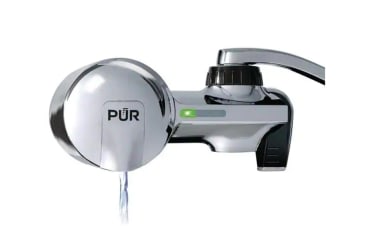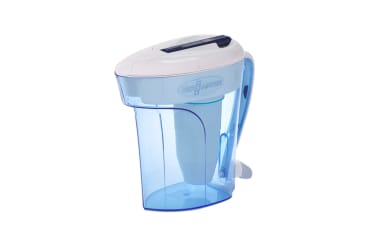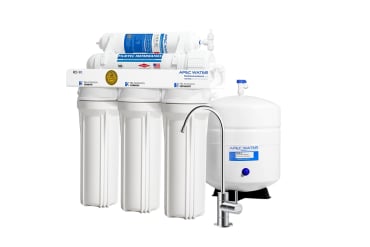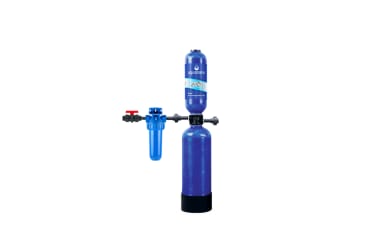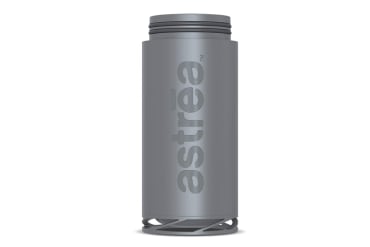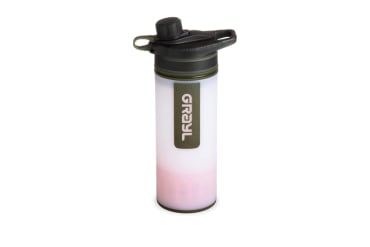Nix the need to buy expensive and unsustainable bottled water with these filter systems that are certified to get rid of the toxins flagged by drinking water experts. These have a layer of activated carbon that can trap larger impurities like lead. Sydney Evans, an Environmental Working Group (EWG) science analyst focused on tap water contaminants, notes that these are the more accessible, understandable, and affordable types of filters. The caveat is they can only tackle so many contaminants. They also need to be regularly replaced, as contaminants can build up inside carbon filters and actually make water quality worse over time. Reverse osmosis filters contain a carbon filter and another membrane(s) to catch smaller contaminants that carbon can’t. “It will filter out virtually everything from your water, to the point where you actually might want to add back some things like salts or minerals to give it some taste,” explains Erik D. Olson, a senior strategic director with the Natural Resources Defense Council (NRDC). While these filters are more effective at trapping small particles, they also tend to be more expensive and difficult to install. Evans also notes that they can waste a fair amount of water as they run, which is something to keep in mind if you live in an area with water shortages. As for which type of filter to choose, it depends on the contaminants in your water source. Every major (serving more than 50,000 people) water utility in the U.S. is legally required to test their water every year and share a public report on the findings. This is called an Annual Water Quality Report, a Right to Know Report, or a Consumer Confidence Report, and it should be easy to access on your utility’s website. You can also head to the EWG’s tap water database to get a quick read on the most recent findings in your area. (These reports don’t account for impurities that might come from your pipe system; to get a complete picture of those, you’ll need to get your home’s water professionally tested1, which is very pricey.) And be prepared: There’s probably a lot to see on your water quality report. Over 300 contaminants have been detected in drinking water systems in the U.S., and Evans explains that “of those, only about 90 are actually regulated.” Even if a certain contaminant is regulated (meaning there is a legal limit on how much of it can be present in tap water), that doesn’t necessarily mean that it’s safe. Olson notes that many of the safe drinking water standards in this country haven’t been updated since the 1970s and 1980s, and are not up to date on the latest scientific findings. They also don’t always account for the fact that while a certain substance may be safe to drink in low doses, it might cause adverse effects when consumed every single day, multiple times a day. “You have an array of things that have an immediate effect, but also things that have effects that take years to show up but are very serious, like cancer,” he notes. Here are a few of the most common tap water contaminants that Evans and Olson see in their work: With this in mind, we went ahead and did the legwork of finding seven filters that approach water cleaning a little differently—but all do it really well. We pored over customer reviews to find the products that have the fewest pain points and make daily use a breeze. The following options span budgets, sizes, and systems, but all earn high marks for how easy they are to install, use, and replace as needed. Each company is transparent about the contaminants that their filters reduce—and has had them independently certified by a third-party tester to do what they say they do. And with significant gaps between what’s legal and what’s safe to be drinking, it’s worth erring on the side of caution and filtering the water you drink daily. “The best solution is for everybody to be getting tap water that is safe and fully tested, so it’s not every man, woman, and child for themselves having to buy and maintain at-home filters,” says Olson. Strengthening drinking water regulations in the U.S. will undoubtedly be a long and complicated process, but you can show your support by reaching out to your local Congress member or an EPA representative to demand safer drinking water standards in your community. Here’s hoping for a day when we won’t need to filter our drinking water at all.









